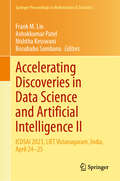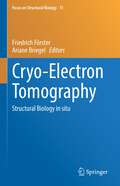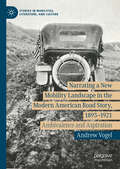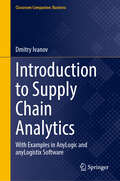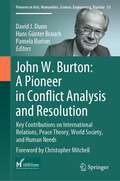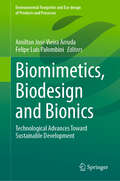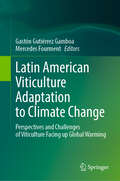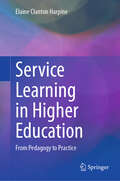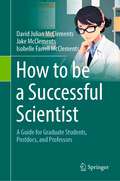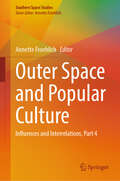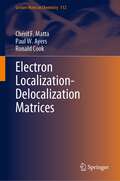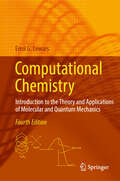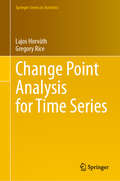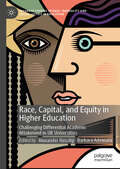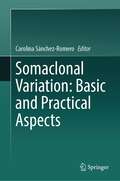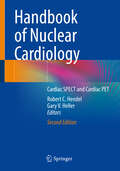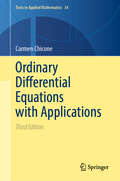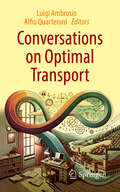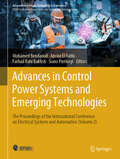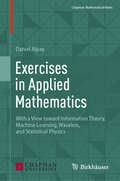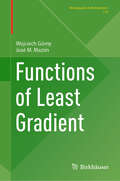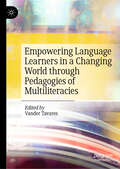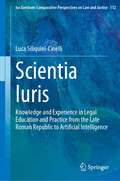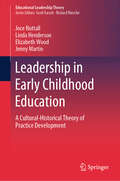- Table View
- List View
Accelerating Discoveries in Data Science and Artificial Intelligence II: ICDSAI 2023, LIET Vizianagaram, India, April 24–25 (Springer Proceedings in Mathematics & Statistics #438)
by Nishtha Kesswani Frank M. Lin Ashokkumar Patel Bosubabu SambanaThis edited volume on machine learning and big data analytics (Proceedings of ICDSAI 2023), that was held on April 24-25, 2023 by CSUSB USA, International Association of Academicians (IAASSE), and Lendi Institute of Engineering and Technology, Vizianagaram, India is intended to be used as a reference book for researchers and practitioners in the disciplines of AI and Data Science. With the fascinating development of technologies in several industries, there are numerous opportunities to develop innovative intelligence technologies to solve a wide range of uncertainties in various real-life problems. Researchers and academics have been drawn to building creative AI strategies by combining data science with classic mathematical methodologies. The book brings together leading researchers who wish to continue to advance the field and create a broad knowledge about the most recent research.
Cryo-Electron Tomography: Structural Biology in situ (Focus on Structural Biology #11)
by Friedrich Förster Ariane BriegelThis book presents key aspects and recent developments of cryogenic sample electron tomography (cryo-ET) methodology, authored by leading experts in the field. Understanding structure and function of biomolecules in the context of cells is a new frontier in cellular and structural biology. To facilitate such research, cryo-ET is a key method to visualize the molecules of life in their native settings. Cryo-ET enables the imaging of samples that are preserved in a near-native state, at (macro)-molecular resolution and in three dimensions. Thus, this technique is a unique tool to gain insights into how biomolecules collaborate in orchestrating fundamental biological processes, how mutations cause diseases, pathogens cause infections, and to develop novel therapeutics to treat such illnesses. This book provides a unique reference for the emerging field of cryo-ET. The topics covered range from the fundamental principles of imaging to sample preparation, data analysis,and data sharing within the scientific community. It serves as a valuable resource for the next generation of structural biologists, making it suitable both for undergraduate students studying biochemistry, biophysics, and molecular biology and highly valuable for the more experienced and specialized PhD student. Furthermore, it stands as a state-of-the–art source of knowledge for the established senior scientist within the field of structural biology.
Narrating a New Mobility Landscape in the Modern American Road Story, 1893–1921: Ambivalence and Aspiration (Studies in Mobilities, Literature, and Culture)
by Andrew VogelThis book examines travel narratives as a medium used by the American public to imagine and negotiate new ways to live in, move through, and share national space. Setting an array of archival material, including congressional deliberations, into analytical conversation with road stories by Walt Whitman, Paul Laurence Dunbar, Upton Sinclair, Emily Post, Zitkala-Ša, Henry Ford and many others, this book reframes our understanding of the origins of American automobility. The evidence gathered here sheds light on the processes by which the defining social infrastructure of the twentieth century came to be enacted, and also exposes the fraught debates and abiding misgivings that continue to roil infrastructure planning today. The insights captured in this study purposefully deepen our attention to questions of land use and collective responsibility at a moment when the ecological and social-justice consequences of American automobility must be thoroughly re-evaluated so that more conscientious mobility futures may be developed.
Introduction to Supply Chain Analytics: With Examples in AnyLogic and anyLogistix Software (Classroom Companion: Business)
by Dmitry IvanovThe book offers a concise yet comprehensive introduction to supply chain analytics covering management, modeling, and technology perspectives. Designed to accompany the textbook “Global Supply Chain and Operations Management”, it addresses the topics of supply chain analytics in more depth. The book describes descriptive, predictive, and prescriptive supply chain analytics explaining methodologies, illustrating method applications with the use of training exercises, and providing numerous examples in AnyLogic and anyLogistix software. Throughout the book, numerous practical examples and short case studies are given to illustrate theoretical concepts. Along with AnyLogic and anyLogistix model development guidelines and examples, the book has two other distinct features. First, it reviews and explains novel frameworks and concepts related to data-driven decision-making and digital twins. Second, it shows how to use analytics to improve supply chain resilience.Without relying heavily on mathematical derivations, the book offers a structured presentation and explanation of major supply chain analytics techniques and principles in a simple, predictable format to make it easy to understand for students and professionals with both management and engineering backgrounds. Graduate/Ph.D. students and supply chain professionals alike would benefit from a structured and didactically-oriented concise presentation of the concepts, principles, and methods of supply chain analytics. Providing graduate students and supply chain managers with working knowledge of basic and advanced supply chain analytics, this book contributes to improving knowledge-awareness of decision-making in increasingly data-driven and digital environments. The book is supplemented by a companion website offering interactive exercises with the use of AnyLogic and anyLogistix software as well as Spreadsheet Modeling.
John W. Burton: Key Contributions on International Relations, Peace Theory, World Society, and Human Needs (Pioneers in Arts, Humanities, Science, Engineering, Practice #33)
by Hans Günter Brauch David J. Dunn Pamela BurtonThis book charts John W. Burton's transition from practitioner in diplomacy to pioneer in the theory of peace research, thinking on world society and conflict resolution. Born in 1915, given his father's name, it was assumed that he would follow his father and become a Christian missionary. He did not: he joined the Australian Public Service. From a junior position he rose rapidly. He was forthright and some found him irritating, or worse. He progressed to the highest levels of policy-making. Amidst some controversy, he resigned abruptly in 1951. He then worked on his farm outside Canberra, writing avidly. He did not intend to become an academic, but in 1963 he was offered a position in International Relations at University College in London and he accepted. He was key to the foundation of the International Peace Research Association (IPRA) in 1964 and of the Conflict Research Society in the UK, because he thought that words and ideas were not enough: there needed to be instrumentsof change. Looking back, he was, in fact, a secular missionary. His aim? Simple: to change the world.· This book is an exploration of how conflict should be reinterpreted.· The ideas of his work are a product not of any metaphysical approach, but of experience. · Burton knew the field: Cold War diplomacy, civil strife, reforming organisations, resistance to change. He had 'been there' and he found much to criticise. · This book illustrates what he had to offer and explains why. These readings reveal shifts in his ideas, cohering incrementally, integrated into a new framework. · This book presents his pioneering and relevant work. Transcending disciplinary boundaries it will be of interest to students, as well as professionals who address conflict at all levels of society, from family to state.
Biomimetics, Biodesign and Bionics: Technological Advances Toward Sustainable Development (Environmental Footprints and Eco-design of Products and Processes)
by Felipe Luis Palombini Amilton José Vieira ArrudaNature is a vast source of inspiration and information for the resolution of complex problems and can influence many varieties of design. Biomimetics, biodesign and bionics are three branches of interdisciplinary research merging biological and applied sciences. This volume collects cases that highlight recent breakthroughs in these disciplines. Biological features such as patterns, shapes, mechanisms, colors, structures, and more can be analyzed, organized, and modeled for application in human creations. Therefore, design, engineering, and architecture projects can benefit from solutions that were already tested and verified through evolution in the natural world. With the development of new technologies for the investigation, simulation, and testing of natural features, the path from nature to product can be accelerated. The cases presented in this work showcase how technological advancements are leading to improved design solutions and influencing our very comprehension of natureand its complex organization.
Latin American Viticulture Adaptation to Climate Change: Perspectives and Challenges of Viticulture Facing up Global Warming
by Gastón Gutiérrez Gamboa Mercedes FourmentLatin American viticulture faces a wide range of difficulties that include social, political, economic, and productive aspects. Soil diversity, together with the climates in which the viticulture activity takes place, favours the production of grapes, juices, raisins, musts, wines, and distillates with unique and distinctive characters for the world. In addition, the great genetic diversity that covers autochthonous and minor grapevine varieties, including unknown genotypes, opens a wide range of research opportunities for the adaptation of the viticulture to the negative effects of global warming, favouring sustainability and social equity. This book compiles the research about the new viticultural trends performed in diverse regions from Latin America such as Argentina, Brazil, Bolivia, Chile, Dominican Republic, Haiti and Uruguay, covering different topics in viticulture of global importance. This book addresses the impacts of soil and climatic conditions and viticultural practices on vine physiology, berry quality and wine typicity, including topics related to social sciences and agricultural economics. This will allow to provide a relevant discussion for future guidelines in viticulture under a territorial development perspective.
Service Learning in Higher Education: From Pedagogy to Practice
by Elaine Clanton HarpineThis practical guide assists university faculty in developing and implementing service-learning courses and projects across multiple disciplines. It examines how embedding academic service-learning projects into the core curricula benefits not only the students, but also their universities and communities. The book describes ways in which service learning becomes a powerful teaching method using step-by-step explanations, real-world examples, and instructor checklists and handouts. Chapters detail how to integrate academic service-learning projects into classroom pedagogy and evaluate student experience.Key areas of coverage include:Strategies for ensuring that students engage with academic service-learning projects from the initial stages through completion.Guidance on embedding an academic service-learning curriculum into traditional coursework to supplement students’ textbook knowledge and classroom experiences to address real-world problems in the community.Research confirming the ways in which students learn more and score higher on end-of-the-semester tests when courses incorporate academic service-learning projects.Steps to incorporate service-learning projects across various disciplines and coursework to enrich student learning and produce positive outcomes for universities and communities. Service Learning in Higher Education is an essential resource for professors and graduate students as well as teachers and educational professionals in such varied fields as school and clinical child psychology, educational psychology, social work, pedagogy, educational practice and policy, sociology, anthropology, and all related disciplines.
How to be a Successful Scientist: A Guide for Graduate Students, Postdocs, and Professors
by David Julian McClements Jake McClements Isobelle Farrell McClementsThis book provides important advice to scientists at all stages of their careers on how to be a more effective and impactful researcher. It provides tips on: designing, performing, and analyzing experiments; writing, submitting and revising manuscripts; preparing and giving scientific talks and posters; writing grant proposals; and writing and defending a graduate thesis. It also provides advice on soft skills, like communication, networking, creativity, critical thinking, and working in teams. A major emphasis of the book is the importance of writing and publishing scientific manuscripts, as this is the main way that scientific knowledge is disseminated, as well as being an important element for building a strong curriculum vitae. The book should be an extremely valuable resource for graduate students throughout their studies but should also be useful for postdocs and professors who want to hone their research skills. The book is written by three scientists from the same family who are each at different stages in their careers and can therefore provide different perspectives. David Julian McClements is a distinguished professor who is currently the most highly cited author in Food Science in the world. He has published over 1300 scientific articles and numerous books. Jake McClements is beginning his career as a lecturer in the United Kingdom, while Isobelle Farrell McClements is just starting her career as a graduate student in the United States.
Outer Space and Popular Culture: Influences and Interrelations, Part 4 (Southern Space Studies)
by Annette FroehlichFollowing on from the highly acclaimed Parts 1 to 3, this book provides detailed insights into how space and popular culture intersect across a broad spectrum of examples, including cinema, music, art, arcade games, cartoons, comics, and advertisements. This is a pertinent topic since the use of space themes differs in different cultural contexts, and these themes can be used to explore various aspects of the human condition and provide a context for social commentary on politically sensitive issues. With the use of space imagery evolving over the past sixty years of the space age, this is a topic ripe for in-depth exploration. The book also discusses the contrasting visions of space from the late nineteenth and early twentieth centuries and the reality of today and analyzes space vehicles and habitats in popular depictions of space from an engineering perspective, exploring how many of those ideas have actually been implemented in practice and why or why not (a case of life imitating art and vice versa). As such, it covers a wide array of relevant and timely topics examining intersections between space and popular culture and offering accounts of space and its effect on culture, language, and storytelling from the southern regions of the world.
Electron Localization-Delocalization Matrices (Lecture Notes in Chemistry #112)
by Chérif F. Matta Ronald Cook Paul W. AyersThis book builds bridges between two yet separated branches of theoretical and mathematical chemistry: Chemical Graph Theory and Electronic Structure Calculations. Although either of the fields have developed their own techniques, problems, methods, and favorite benchmark cases independent from each other, the authors have managed to bring them together by using the localization-delocalization matrix (LDM). The LDM is a novel molecular descriptor that fingerprints a molecule by condensing the complicated electronic information in one, mathematically manageable, object. In this book, the authors introduce the readers to modeling techniques based on LDMs. Their technique offers a high accuracy as well as robust predictive power, often dramatically surpassing the potential of either of the constituting methods on their own. In addition to the comprehensive and accessible introduction to this new field of theoretical chemistry, the authors offer their self-developed software free to download, so that readers can try running their own simulations. The described methods are very general and can easily be implemented for calculating various properties and parameters such as mosquito repelling activity, ionic liquid properties, local aromaticity of ring molecules, log P's, pKa's, LD50, corrosion inhibition activities, and Lewis acidities and basicities – to only name a few. The free downloadable software helps readers automate the analysis of the matrices described in this book and hence facilitates application of the described methodology.
Aesthetic Procedures: Nurse Practitioner's Guide to Cosmetic Dermatology
by Beth HaneyThis second edition is a resource that offers guidance to advanced practice providers who are experienced or novice aesthetic practitioners and would like to improve their aesthetic practice and enhance patient safety and satisfaction. This new book reviews skin structure and anatomy, what happens as facial structures age, the effects of aging coupled with environmental exposures, pharmacology of medications used in aesthetics, light-based device properties, patient selection, danger zones, complications, new treatments, and benefits of treatments. In addition, it includes suggestions on how to communicate with patients to achieve successful outcomes. Aesthetic Procedures: Nurse Practitioner's Guide to Cosmetic Dermatology provides practitioners a one-source resource to attain more in-depth learning about cosmetic dermatology. Although there are several texts on individual aspects of aesthetic medicine, there is no all-inclusive book for advanced practice providers. This book also affords the primary care practitioner the opportunity to add minimally invasive cosmetic dermatology procedures to their practice and perform the treatments safely, efficiently and effectively while avoiding common mistakes and minimizing complication risks. Education and hands-on practice and training are paramount in creating a safe patient environment and as more clinicians turn to aesthetics to augment their practice, this book will be a valuable resource for practitioners all over the world.
Computational Chemistry: Introduction to the Theory and Applications of Molecular and Quantum Mechanics
by Errol G. LewarsThis is the fourth edition of the successful textbook on computational chemistry which continues to provide a comprehensive introduction to the theory and practice of computational chemistry. Notable updates include a review of references up to mid-2023, encompassing recent developments in scientific journals, books, and software. The evolving prominence of density functional theory (DFT) is emphasized, and attention is given to the increasing application of artificial intelligence in computational chemistry. The book maintains key features from the previous edition, delving into the mathematical intricacies of ab initio and density functional methods at an introductory level. Clear explanations of matrix methods are provided, offering a direct approach to obtaining energy levels and molecular orbitals. Additionally, each chapter includes sets of "Easier" and "Harder" drill questions, with suggested answers at the end of the book, enhancing the learning experience. The book is intended for upper-year undergraduate and graduate students studying computational and theoretical chemistry and for self-study by researchers in universities and industry to whom computational chemistry may be useful.
Change Point Analysis for Time Series (Springer Series in Statistics)
by Lajos Horváth Gregory RiceThis volume provides a comprehensive survey that covers various modern methods used for detecting and estimating change points in time series and their models. The book primarily focuses on asymptotic theory and practical applications of change point analysis. The methods discussed in the book go beyond the traditional change point methods for univariate and multivariate series. It also explores techniques for handling heteroscedastic series, high-dimensional series, and functional data. While the primary emphasis is on retrospective change point analysis, the book also presents sequential "on-line" methods for detecting change points in real-time scenarios. Each chapter in the book includes multiple data examples that illustrate the practical application of the developed results. These examples cover diverse fields such as economics, finance, environmental studies, and health data analysis. To reinforce the understanding of the material, each chapter concludes with several exercises.Additionally, the book provides a discussion of background literature, allowing readers to explore further resources for in-depth knowledge on specific topics. Overall, "Change Point Analysis for Time Series" offers a broad and informative overview of modern methods in change point analysis, making it a valuable resource for researchers, practitioners, and students interested in analyzing and modeling time series data.
Race, Capital, and Equity in Higher Education: Challenging Differential Academic Attainment in UK Universities (Palgrave Studies in Race, Inequality and Social Justice in Education)
by Alexander Hensby Barbara AdewumiThis book examines the structural and cultural factors that explain the persistence of an attainment gap between white and Black, Asian, and Minority Ethnic (BAME) students in UK universities. So-called ‘deficit’ approaches have long represented the orthodoxy in higher education strategy-making, yet they overlook the structural and institutional factors that reproduce attainment gaps. Whereas students already in possession of the right ‘academic capital’ are made to feel validated and empowered in their learning, BAME students – particularly those from working class backgrounds – may feel marginalised by dominant hierarchical cultures on campus.This book provides an important and unique contribution to the study of racial equity in higher education. Its chapters provide a breadth and depth of analyses which help explain the roots of the attainment gap, while offering reflections and commentaries on the necessary steps that universities must take in order to ensure equityfor students from all backgrounds.
Somaclonal Variation: Basic and Practical Aspects
by Carolina Sánchez-RomeroThis book is fundamental for plant biotechnologists at this moment, due to the extensive use of in vitro culture. Although some books about somaclonal variation were published some years ago, the circumstances in this field have undergone a great change in the last years. Much progress has been achieved in plant in vitro culture: new technologies have been developed, previously used protocols have been modified with regard to optimization, and in vitro techniques have been applied to new species. Besides, tools for somaclonal variation analysis have also changed in the last years. The techniques and instruments have substantially improved, with the development of new molecular markers and the increased precision and sensitivity of some instruments. Furthermore, novel knowledge about the basic mechanisms underlying somaclonal variation has been obtained recently, which can be very useful for explaining the variability found in different experimental systems.Therefore, it is evident that information about basic and practical aspects of somaclonal variation requires updating and the proposed book is a very good means for this purpose.
Handbook of Nuclear Cardiology: Cardiac SPECT and Cardiac PET
by Gary V. Heller Robert C. HendelThis extensively revised edition of this important textbook provides a practical approach to the use of nuclear cardiology for the general cardiologist. It is an adjunct to the existing literature in nuclear cardiology, providing a simple case-based approach to understanding the methodology, application and outcomes of the modality, and representing a pocket-sized compendium designed for a clinical cardiology audience. Nuclear cardiology procedures have been a mainstay in noninvasive testing for the diagnosis and risk stratification of coronary artery disease for many years. Although a mature field with a multitude of clinical applications, the advances in the technology and imaging procedures have been remarkable and important to document.Handbook of Nuclear Cardiology: Cardiac SPECT and Cardiac PET reviews the important indications for choosing nuclear cardiology procedures and provides a description of the procedures themselves, including both SPECT and PET imaging protocols, as well as supplying readers with a the key readings resources. It emphasizes how noninvasive testing results can be used clinically and the appropriateness of such techniques using a concise and logical structure, vital for trainees, practicing physicians, nurses and technologists looking for a brief, up-to-date overview and reference volume for nuclear cardiology. It therefore represents an essential reference for a large number of cardiologists internationally looking for information in the field.
Ordinary Differential Equations with Applications (Texts in Applied Mathematics #34)
by Carmen ChiconeThis book, developed during 20 years of the author teaching differential equations courses at his home university, is designed to serve as a text for a graduate level course focused on the central theory of the subject with attention paid to applications and connections to other advanced topics in mathematics. Core theory includes local existence and uniqueness, the phase plane, Poincaré-Bendixson theory, Lyapunov and linearized stability, linear systems, Floquet theory, the Grobman–Hartman theorem, persistence of rest points and periodic orbits, the stable and center manifold theorems, and bifurcation theory. This edition includes expanded treatment of deterministic chaos, perturbation theory for periodic solutions, boundary value problems, optimization, and a wide range of their applications. In addition, it contains a formulation and new proof of a theorem on instability of rest points in the presence of an eigenvalue with positive real part, and new proofs of differential inequalities and Lyapunov’s center theorem. New sections present discussions of global bifurcation, the Crandall–Rabinowitz theorem, and Alekseev’s formula. Of particular note is a new chapter on basic control theory, a discussion of optimal control, and a proof of a useful special case of the maximum principle. A key feature of earlier editions, a wide selection of original exercises, is respected in this edition with the inclusion of a wealth of new exercises. Reviews of the first edition:“As an applied mathematics text on linear and nonlinear equations, the book by Chicone is written with stimulating enthusiasm. It will certainly appeal to many students and researchers.”—F. Verhulst, SIAM Review “The author writes lucidly and in an engaging conversational style. His book is wide-ranging in its subject matter, thorough in its presentation, and written at a generally high level of generality, detail, and rigor.”—D. S. Shafer, Mathematical Reviews
Conversations on Optimal Transport
by Luigi Ambrosio Alfio QuarteroniThis work is closely tied to the renowned mathematics textbook series known as UNITEXT, tailored for university students pursuing bachelor’s or master’s degrees. What sets this particular book apart in the Springer collection is its unique origin: it has been crafted through a meticulous process involving interviews handled with and by world-class mathematicians. The content featured in this book revolve around a highly relevant and engaging topic: Optimal Transport. These conversations involve not only authors from the UNITEXT series, but also members of the series’ Editorial Board. Additionally, they feature prominent figures in the field, including a Field Medalist. This work provides readers with a snapshot of remarkable vitality and freshness, guaranteed to captivate and engage anyone with an interest in mathematics. It’s important to note that these interviews were initially shared as podcasts and originally broadcasted as online events on the Cassyni platform. Subsequently, advanced AI tools were employed under human supervision to transcribe the audios and edit them for better readability. A human copy-editor was involved during the whole process, and the authors revised the final copy-edited texts before publication. The content in each format – the interviews, the PODCASTS and the book – is self-contained and not a mere adaptation from one medium to another. Instead, it represents an independent exploration of the subject matter.
Advances in Control Power Systems and Emerging Technologies: The Proceedings of the International Conference on Electrical Systems and Automation (Volume 2) (Advances in Science, Technology & Innovation)
by Farhad Ilahi Bakhsh Mohamed Bendaoud Amine El Fathi Siano PierluigiThis edited book is an outcome of the selected papers presented at the International Conference on Electrical Systems & Automation, (ICESA 2023) held from 29 to 30 May 2023 at the Faculty of Sciences and Technologies, Al Hoceïma, Morocco. This edited book is divided into two volumes. This volume is divided into four parts, each devoted to distinct yet interconnected aspects of the subject matter. The first part presents the control of electrical machines and power converters. It covers a comparative study of different control approaches, including Proportional-Integral (PI), Fuzzy Logic, and Neural Fuzzy Logic Controllers for Boost Converters. It also presents an innovative approach for single-phase half-bridge inverters and improved direct torque control of dual three-phase permanent magnet synchronous motors. Part 2 of the book, titled "Control Systems & Automation", thoroughly explores advanced control and automation technologies in electrical systems. These chapters collectivelyshowcase the latest developments and research across various engineering domains. Several control approaches have been discussed such as fuzzy control, sliding mode control, artificial neural networks (ANN), and machine learning. The third part highlights emerging technologies and applications in various fields such as mobile robots, industry 4.0, agriculture, and health. The chapters cover a wide range of topics, including intelligent navigation for autonomous robots, self-driving car perception and pedestrian detection, machine learning for cloud and IoT-based smart agriculture, outdoor navigation systems for micro-tractors, healthcare intelligent systems for melanoma image classification, maximizing the performance of Light Emitting Diode Luminaires. The research explores innovative solutions and technologies in different domains, aiming to improve functionality in various applications. Part 4 of this book is dedicated to "Advanced Wireless Communication and Antenna Technology". This part explores cutting-edge developments and innovations in the realm of wireless communication and antenna design, with a focus on their applications and impact in various fields.
Exercises in Applied Mathematics: With a View toward Information Theory, Machine Learning, Wavelets, and Statistical Physics (Chapman Mathematical Notes)
by Daniel AlpayThis text presents a collection of mathematical exercises with the aim of guiding readers to study topics in statistical physics, equilibrium thermodynamics, information theory, and their various connections. It explores essential tools from linear algebra, elementary functional analysis, and probability theory in detail and demonstrates their applications in topics such as entropy, machine learning, error-correcting codes, and quantum channels. The theory of communication and signal theory are also in the background, and many exercises have been chosen from the theory of wavelets and machine learning. Exercises are selected from a number of different domains, both theoretical and more applied. Notes and other remarks provide motivation for the exercises, and hints and full solutions are given for many. For senior undergraduate and beginning graduate students majoring in mathematics, physics, or engineering, this text will serve as a valuable guide as theymove on to more advanced work.
Functions of Least Gradient (Monographs in Mathematics #110)
by José M. Mazón Wojciech GórnyThis book is devoted to the least gradient problem and its variants. The least gradient problem concerns minimization of the total variation of a function with prescribed values on the boundary of a Lipschitz domain. It is the model problem for studying minimization problems involving functionals with linear growth. Functions which solve the least gradient problem for their own boundary data, which arise naturally in the study of minimal surfaces, are called functions of least gradient. The main part of the book is dedicated to presenting the recent advances in this theory. Among others are presented an Euler–Lagrange characterization of least gradient functions, an anisotropic counterpart of the least gradient problem motivated by an inverse problem in medical imaging, and state-of-the-art results concerning existence, regularity, and structure of solutions. Moreover, the authors present a surprising connection between the least gradient problem and the Monge–Kantorovich optimal transport problem and some of its consequences, and discuss formulations of the least gradient problem in the nonlocal and metric settings. Each chapter is followed by a discussion section concerning other research directions, generalizations of presented results, and presentation of some open problems. The book is intended as an introduction to the theory of least gradient functions and a reference tool for a general audience in analysis and PDEs. The readers are assumed to have a basic understanding of functional analysis and partial differential equations. Apart from this, the text is self-contained, and the book ends with five appendices on functions of bounded variation, geometric measure theory, convex analysis, optimal transport, and analysis in metric spaces.
Empowering Language Learners in a Changing World through Pedagogies of Multiliteracies
by Vander TavaresThis book presents conceptual and empirical studies on how pedagogies of multiliteracies can empower language learners, teachers, and teacher educators in an increasingly globalized yet unequal world, with a focus on social justice in language education. The chapters offer critical and innovative pedagogical insights that contribute to re-envisioning language and literacy education in the 21st century in a number of educational contexts, including post-secondary, community, refugee, science, language, and teacher education. From a raciolinguistic critique of monoglossic education in the United States to drama-based pedagogies for refugee learners in Iceland, this book contextualizes language learner empowerment by identifying and confronting ideologies of race, gender, nationality, and language. Creative multimodal and multisensorial pedagogies are enacted through learner-designed plurilingual portfolios, infographics, picturebooks, identity texts, performance, andmuseum-based learning. This book diversifies and enriches current approaches to language education based on pedagogies of multiliteracies that cultivate learner agency, identity, and critical reflection, and it will be of interest to readers with backgrounds in second/foreign language education, TESOL/ESL, sociology of education, and applied linguistics.
Scientia Iuris: Knowledge and Experience in Legal Education and Practice from the Late Roman Republic to Artificial Intelligence (Ius Gentium: Comparative Perspectives on Law and Justice #112)
by Luca Siliquini-CinelliLaw’s regulatory reach has grown significantly over the past few decades. Yet, at the same time, law schools and legal professions in Western and Western-oriented jurisdictions have undergone an acute crisis. How is this possible? In this insightful and wide-ranging book, Luca Siliquini-Cinelli argues that these trends are in fact complementary manifestations of a single phenomenon—namely, that law is and will always be more capable of regulating social interaction without the experiential contribution of legal experts. Siliquini-Cinelli contends that the separation of law’s regulatory function from legal experts is structurally linked to the former’s nature and operational dynamics as an intellectual artifact to be used for ordering purposes. As a product of the intellect, law is a matter of knowledge, not experience. In fact, Siliquini-Cinelli holds, law’s artifactuality voids experience, including that of legal experts, making it redundant. This explains how law can thrive as a regulatory phenomenon while the very places where future legal professionals are formed and those places where it is practised are in crisis. To show this, Siliquini-Cinelli embarks upon a historical, philosophical, and comparative analysis of law’s artifactuality, focusing on the teaching, study and practise of law as intellectual endeavours, from the advent of juristic activities in the Late Roman Republic to current legal pedagogies, practices, and reforms in Civil and Common law jurisdictions. In so doing, Siliquini-Cinelli employs the Latin phrase ‘scientia iuris’ to explain why and how legal education and practice pursue knowledge at the expense of experience, and the serious implications this has for lawyering activities. Moving beyond established narratives, Siliquini-Cinelli argues that ‘scientia iuris’ ought not be reduced to dogmatic analysis (scientia iuris as doctrina iuris). Rather, ‘scientia iuris’ denotes the knowledge of the law sought by all those who teach, study, and practise it, and which is actualised through a form of legal thinking and argumentation that moves along reason’s metaphysical, constructivist lines (scientia iuris as cognitio iuris). Thus, scientia iuris is not the prerogative of a few legal scholars; rather, it lies at the very core of Western legal education and practice, broadly understood. The relevance of Siliquini-Cinelli’s original and interdisciplinary analysis is profound and far-reaching: the crisis that legal education and practice are undergoing is not an isolated, or accidental, event; it is a consequence of the very ways in which law has been taught, studied, and practised since Rome. Endorsements ‘This richly researched book on the history of scientia iuris is a work on epistemology which argues that the legal model is highly problematic and will eventually be able to function without the intervention of jurists and lawyers. Such a thesis is based upon a very detailed knowledge both of philosophy and of the legal primary and secondary sources from Roman to modern times. The author is at home with Ancient Greek, Latin, French, German and Italian texts and this means that the research basis for the thesis not only is unusually profound – encompassing both the civil and the common law – but will make a major contribution to historical jurisprudence, to comparative legal history, to comparative law in general and to legal theory. This is legal scholarship of the highest order.’ Geoffrey Samuel, Emeritus Professor of Law, Kent Law School ‘In this exceptionally robust and expertly-researched new book, Luca Siliquini-Cinelli presents a provocative thesis. He proposes that the experience of legal experts is redundant when it comes to the success of law as a regulatory framework. Oscillating between historical, material, philosophical and literary frames, Siliquini-Cinelli introduces what he terms ‘law’s artifactuality’. Law’s artifac
Leadership in Early Childhood Education: A Cultural-Historical Theory of Practice Development (Educational Leadership Theory)
by Elizabeth Wood Jenny Martin Joce Nuttall Linda HendersonThe book presents a conceptual framework for understanding leadership for effective educator learning in early childhood settings. The book describes how leaders can move centre practices from crisis to stabilization. It argues that a core component of leaders' work in early childhood settings is to construct and enact epistemological accounts of practice change. The book includes case examples that bring to life the contexts early childhood services and services leaders who participated in the research. The book also describes the application of cultural-historical activity theory to the development of practice in early childhood education. It describes how background theory, literature, and data can be synthesized to create new focal theory in education. Readers will benefit from the theory that is presented, establishing a sound basis for testing in future research in schools as well as in early childhood education. “Joce Nuttall and team are congratulated for their ground-breaking scholarly endeavour in designing, implementing, validating findings, and then writing a book that unambiguously connects theory-policy-practice in enacting leadership in early childhood settings. This book is ambitious, eloquent, and inspirational. The research was driven by a bold vision to build a new theorisation of early childhood leadership. The writing style of the book makes the complex clear and easy to digest, and thereby strengthening its readability and understanding. The comparative lens adopted in the study, underscores the neoliberal control of the working lives of early childhood leaders in both Australia and England. The use of case study narratives to explain various aspects including the study design and methodology, was refreshingly engaging. Notes of encouragement addressed to novice researchers such as those embarking on higher degree studies, also provide apt guidance about the messiness of conducting qualitative research. The book is infused with lots of examples demonstrating the transformative power of learning – especially when expertly scaffolded by the research team, and thereby increasing practitioner agency and quality improvement across the early childhood setting. If professional autonomy is the driver of reform and change, then we must find ways to nurture strong educational leaders who can think outside the box. Overall, Nuttall and team succeed in arousing learning-rich possibilities for reimagining early childhood leadership in theory and in practice, and thereby making a magnificent contribution to the scholarship of educational leadership.” Professor Manjula Waniganayake PhD, Macquarie University, Sydney, Australia
